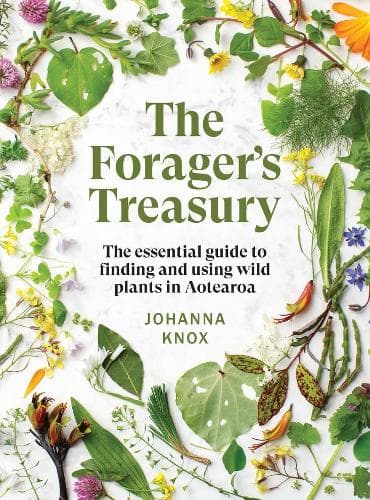Review: The Forager’s Treasury: The essential guide to finding and using wild plants in Aotearoa
Reviewed by André Taber
When I was about three-quarters through reading The Forager’s Treasury I found myself, when out doing errands, slowing down to look for edible plants in the edges of parks and unkempt front gardens. That has to be the best recommendation for a book on foraging.
New Zealand has many plant species that the rest of the world simply doesn’t know about, and if you want to forage them you won’t learn much on the internet, so this book is an important resource. It’s revised and updated from the first edition, published in 2013, and Johanna Knox (Ngāti Tukorehe, Ngāti Kahu ki Tauranga) is refreshingly honest about the improvements: it now has an index, it reflects evolving gathering “lore,” some plants are now officially classified “at risk” and should no longer be foraged, and Knox’s education in Māoritanga has changed some of the ways she approaches foraging.
It’s an easy book to browse and Knox’s writing style is clear, though not precise – little is definitive when it comes to foraging and she always errs on the side of caution. In the introductory chapters, you’ll learn about history, equipment, rules and regulations, pollution and poisonous plants. Knox swings between philosophy, politics, humour, folksy idealism and precise scientific information – a lot to take in but you’re genuinely interested in foraging you will breeze through these chapters.
Making up roughly half the book, the guide to plants (or “treasures,” as Knox refers to them) is organised alphabetically by botanical family, then each plant is listed with its Māori name, common English names and botanical name, followed by sections on “spotting them,” mostly but not always with photos to help identification, and “using them.”
“Foraging throws open the doors to a pantry of ingredients that are often new and exciting yet also have reassuringly familiar qualities,” Knox writes. It’s not just about finding edible weeds: citrus trees, which are equally forageable, are covered. But fungi are not – there is a lot more complexity (and risk of poisoning) in wild mushrooms that Knox is not willing to tackle here.
Once you have foraged, the rest of the book tells you how to use it: preserving, cooking, medicinal, perfumes, dyes. The last chapter is on playing – keeping children engaged while foraging.
There are a few shortcomings in The Forager’s Treasury. For example, Knox uses technical terms like “leaf nodes” and “sepals” without explanation for those less experienced with plants. Samphire is a trendy food at the moment but it’s not in the index under S – in order to find it you need to know that New Zealand’s variety is more correctly called ureure or glasswort.
But the best way to review a book about foraging is to actually get out there and do some foraging. I’m not a novice forager; for most of my adult life I have been interested in the idea that there’s free wild food available and I have occasionally been motivated to pick it too. I was inspired by The Forager’s Treasury to seek out seaweed, dandelion root and kawakawa leaves and fruit. In the interest of avoiding spoilers, I won’t describe my foraging trips around Auckland in detail, but they produced mixed results. The Forager’s Treasury won’t turn you into an instant expert – it’s the sort of thing you need to learn slowly by sticking at it. As Knox writes, “Each of us forages differently. We have our own gathering routines, favourite plants, and methods of harvest and use.”
This guide is suitable for beginners through to experience foragers who want to brush up or find new challenges. The evocative photography by Lottie Hedley deserves a mention, too.
Reviewed by André Taber
